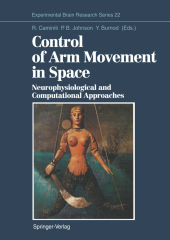 Neuerscheinungen 2011Stand: 2020-01-07 |
Schnellsuche
ISBN/Stichwort/Autor
|
Herderstraße 10
10625 Berlin
Tel.: 030 315 714 16
Fax 030 315 714 14
info@buchspektrum.de |

Ives Burnod, Roberto Caminiti, Paul B. Johnson
(Beteiligte)
Control of Arm Movement in Space
Neurophysiological and Computational Approaches
Herausgegeben von Caminiti, Roberto; Johnson, Paul B.; Burnod, Ives
2011. xii, 338 S. XII, 338 pp. 64 figs. 242 mm
Verlag/Jahr: SPRINGER, BERLIN 2011
ISBN: 3-642-77237-4 (3642772374)
Neue ISBN: 978-3-642-77237-5 (9783642772375)
Preis und Lieferzeit: Bitte klicken
The primate forearm is capable of an infinite variety of motions which are performed with power, speed, and finesse. How the brain generates and controls such movements has intrigued and baffled students of motor control for centuries. However, progress toward the better understanding of arm movement control is now being made by researchers in several disciplines. This volume brings together contributions from the fields of neuroanatomy, neurophysiology, behavior, and computational neuroscience. Each chapter presents recent data from current research topics relevant to the problem of controlling arm and hand movements. The multidisciplinary approach adopted in this volume reflects the current trend to combine the methodologies of neuroscience with those of engineering. In this sense, special emphasis has been given to computational developments which have their basis in recent experimental results. Correlations between behavioral motor variables and neural activity in various brain regions, the neural mechanisms of reaching and manipulation control and their underlying visuomotor transformation, and the internal neuronal representation of motor space as seen through population codes, are the main topics treated at both physiological and computational level. . We hope that this volume will help both physiologists to better understand the theoretical bases underlying the neural control of movement, and students of neural networks to adopt more biologically-oriented approaches in their development of new computational strategies.
Activation of Mono- and Biarticular Muscles in Multijoint Movements.- Coordinate Transformations in the Control of Limb Stiffness.- Parallel Visuomotor Processing in Human Prehension Movements.- Bimanual Synergies in Primates.- Inputs from the Cerebellar Nuclei to the Forelimb Area of the Motor Cortex.- Anatomo-Functional Panellation of the Agranular Frontal Cortex.- Organization and Adaptability of Muscle Representations in Primary Motor Cortex.- Comparison of Cell Discharge in Motor, Premotor, and Parietal Cortex During Reaching.- Reaching Toward Visual Targets. I. Neurophysiological Studies.- Reaching Toward Visual Targets. II. Computational Studies.- Motor Cortex: A Changing Perspective.- Hand-Movement-Related Neurons of the Posterior Parietal Cortex of the Monkey: Their Role in Visual Guidance of Hand Movements.- Toward an Understanding of the Cerebral Cortex and Reaching Movements: A Review of Recent Approaches.- Correlation Analysis of Relations Between Red Nucleus Discharge and Limb Muscle Activity During Reaching Movements in Space.- A Model of the Effects of Speed, Accurancy and Perturbation on Visually Guided Reaching.- The Control of Arm-, Gaze-, and Head-Movements by Listing´s Law.- The Organization of Limb Motor Space in the Spinal Cord.


